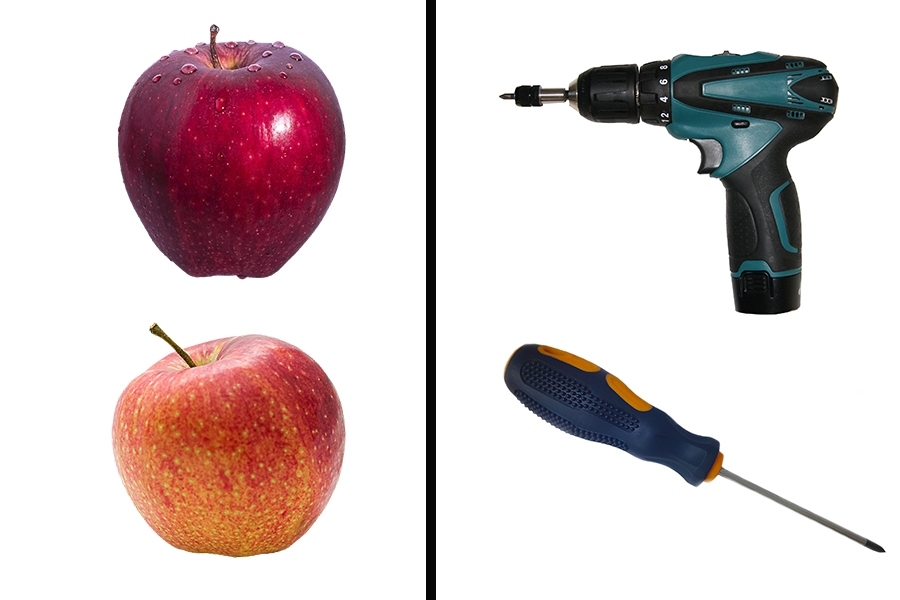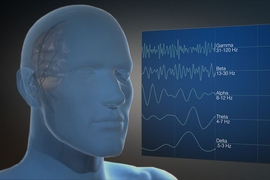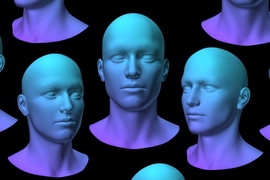We categorize pretty much everything we see, and remarkably, we often achieve that feat whether the items look patently similar — such as Fuji and McIntosh apples — or they share a more abstract similarity — such as a screwdriver and a drill. A new study at MIT’s Picower Institute for Learning and Memory explains how.
“Categorization is a fundamental cognitive mechanism,” says Earl Miller, the Picower Professor in MIT’s Picower Institute for Learning and Memory and the Department of Brain and Cognitive Sciences. “It’s the way the brain learns to generalize. If your brain didn’t have this ability, you’d be overwhelmed by details of the sensory world. Every time you experienced something, if it was in different lighting or at a different angle, your brain would treat it as a brand new thing.”
In the new paper in Neuron, Miller’s lab, led by postdoc Andreas Wutz and graduate student Roman Loonis, shows that the ability to categorize based on straightforward resemblance or on abstract similarity arises from the brain’s use of distinct rhythms, at distinct times, in distinct parts of the prefrontal cortex (PFC). Specifically, when animals needed to match images that bore close resemblance, an increase in the power of high-frequency gamma rhythms in the ventral lateral PFC did the trick. When they had to match images based on a more abstract similarity, that depended on a later surge of lower-frequency beta rhythms in the dorsal lateral PFC.
Miller says those findings suggest a model of how the brain achieves category abstractions. It shows that meeting the challenge of abstraction is not merely a matter of thinking the same way but harder. Instead, a different mechanism in a different part of the brain takes over when simple, sensory comparison is not enough for us to judge whether two things belong to the same category.
By precisely describing the frequencies, locations, and the timing of rhythms that govern categorization, the findings, if replicated in humans, could prove helpful in research to understand an aspect of some autism spectrum disorders (ASD), says Miller. In ASD, categorization can be challenging for patients, especially when objects or faces appear atypical. Potentially, clinicians could measure rhythms to determine whether patients who struggle to recognize abstract similarities are employing the mechanisms differently.
Connecting the dots
To conduct the study, Wutz, Loonis, Miller, and their co-authors measured brain rhythms in key areas of the PFC associated with categorization as animals played some on-screen games. In each round, animals would see a pattern of dots — a sample from one of two different categories of configurations. Then the sample would disappear and after a delay, two choices of dot designs would appear. The subject’s task was to fix its gaze on whichever one belonged to the same category as the sample. Sometimes the right answer was evident by sheer visual resemblance, but sometimes the similarity was based on a more abstract criterion the animal could infer over successive trials. The experimenters precisely quantified the degree of abstraction based on geometric calculations of the distortion of the dot pattern compared to a category archetype.
“This study was very well-defined,” says Wutz. “It provided a mathematically correct way to distinguish something so vague as abstraction. It’s a judgment call very often, but not with the paradigm that we used.”
Gamma in the ventral PFC always peaked in power when the sample appeared, as if the animals were making a “Does this sample look like category A or not?” assessment as soon as they were shown it. Beta power in the dorsal PFC peaked during the subsequent delay period when abstraction was required, as if the animals realized that there wasn’t enough visual resemblance and deeper thought would be necessary to make the upcoming choice.
Notably, the data was rich enough to reveal several nuances about what was going on. Category information and rhythm power were so closely associated, for example, that the researchers measured greater rhythm power in advance of correct category judgments than in advance of incorrect ones. They also found that the role of beta power was not based on the difficulty of choosing a category (i.e., how similar the choices were) but specifically on whether the correct answer had a more abstract or literal similarity to the sample.
By analyzing the rhythm measurements, the researchers could even determine how the animals were approaching the categorization task. They weren’t judging whether a sample belonged to one category or the other, says Wutz. Instead they were judging whether they belonged to a preferred category or not.
“That preference was reflected in the brain rhythms,” says Wutz. “We saw the strongest effects for each animal’s preferred category.”
Tim Buschman, assistant professor in the Princeton Neuroscience Institute and Department of Psychology at Princeton University, says the study helps to explain a crucial aspect of the brain’s ability to generalize: flexibility.
“Once we see one dog bark, we instantly know that all dogs bark. However, there is a right amount to generalize; we don’t want to learn that all four-legged mammals bark,” says Buschman. “The current manuscript provides insight into how the brain flexibly modulates how much we should generalize — a little (all dogs bark) or a lot (all mammals have hair). The study provides new insight into how the brain flexibly switches between two different modes — there is a ‘bottom-up’ mode that is rooted in the more concrete representations of our senses, allowing for a little generalization; and a ‘top-down’ mode that uses higher-order brain regions to generalize more broadly.
“This study is an important first step in understanding how the brain generalizes knowledge and lays the groundwork for understanding cognitive conditions, such as autism, that impair one’s ability to generalize,” says Buschman.
The National Institute of Mental Health funded the study, which was co-authored by graduate student Jacob Donoghue and research scientist Jefferson Roy.










